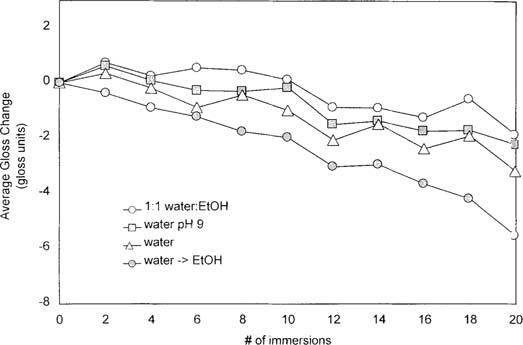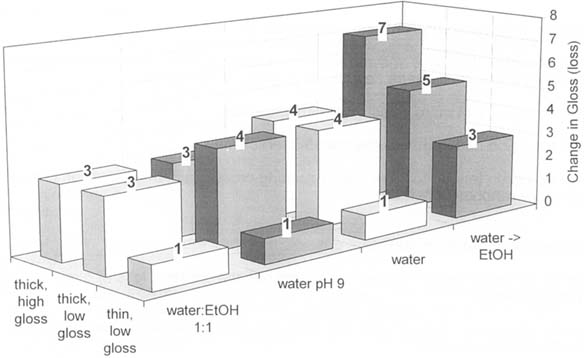
Topics in Photographic Preservation 1997, Volume 7, Article 6 (pp. 38-42)
It has been shown that wet treatment may encourage emulsion cracking (Messier & Vitale, 1993). Nevertheless, it is sometimes necessary to use water in the treatment of albumen prints. The purpose of this study was to identify commonly used aqueous treatments and compare their effects on the surfaces of newly manufactured albumen prints.
Four baths were chosen for this study, based on techniques in general use:
We expected that the least surface deterioration would be caused by the water:ethanol mixture, since this bath, having the least amount of water, should induce the least amount of swelling in the emulsion. Following this same reasoning, we anticipated that water followed by ethanol would also produce good results. Conversely, we expected that water alone would produce slightly more damaging effects, and water ammoniated to pH 9 would cause even greater damage due to the elevated pH.
Sample preparation
Albumenized papers were sensitized, exposed and processed (Reilly, 1980). The prints were exposed to maximum density, without negatives, as the dark background was expected to show cracking to best advantage. After processing, the papers could be divided into three broad categories, based on their initial gloss and emulsion thickness:
Treatment
Treatment consisted of twenty cycles of bathing for thirty minutes followed by drying under blotters, felts, and weight.
Measurement
The developing cracks will scatter light, causing a reduction of surface gloss. Changes in the surface of the emulsion were monitored using a Novogloss 20/60/85 glossmeter. Gloss measurements were obtained at 60 and 85 degrees and yielded virtually identical results. The results obtained at 85 degrees are presented in Figures 1 and 2. The gloss measurements were normalized to the initial gloss to facilitate comparison of the gloss changes. In Figure 1, the average gloss change for all paper types is plotted against the number of immersions in each of the four baths (each bath is represented by a different line). In Figure 2, the height of the bars represents the average loss in gloss for each paper type in each of the four baths over the course of the twenty treatment cycles.

Figure 1: Average gloss change for all papers in the study as a function of the number of immersions in each of the four treatment baths. The gloss measurements have been normalized to the initial gloss of the paper.

Figure 2: The change in gloss (averaged over the course of the twenty treatments cycles) for each of the three paper types in each of the four baths.
Comparison of baths (see Figure 1)
All treated prints lost gloss, regardless of initial gloss or emulsion thickness.
Different amounts of reduction in gloss were observed for each bath:
Comparison of paper characteristics (see Figure 2)
Prints of similar thickness showed similar amounts of gloss reduction whether their initial appearance was matte (low gloss) or glossy (high gloss).
Thick emulsion lost more gloss than thin emulsion.
Thick emulsion had larger cracks than thin emulsion.
Thick emulsion tended to have cracks running cross-grain; thin emulsion cracks were more randomly oriented.
Comparing all baths: water followed by ethanol has the greatest loss of gloss, for all three paper types.
Comparing all papers: the samples with thick emulsion consistently lost more gloss than those with thin emulsion.
Comparing the papers with thick emulsions: the loss of gloss is independent of initial gloss.
The reduction in gloss appears to be related to the amount of stress placed upon the emulsion during the wetting and drying cycle.
More cracking and gloss reduction is seen in thicker emulsions than in thin emulsions, possibly from increased stresses due to greater differences in mechanical behavior between the albumen emulsion and the paper substrate.
The least amount of cracking and gloss reduction is seen with the water:ethanol (1:1 v/v) mixture, when swelling is reduced.
The greatest amount of cracking and gloss reduction is seen with the water followed by ethanol treatments, when the prints go quickly from a swollen to a dry state.
The following recommendations for albumen prints that require aqueous treatment result from this study:
Limit swelling during bathing (use a water-ethanol mixture if advisable).
Dry prints slowly after wetting, under restraint.
Our results indicate that bathing in water ammoniated to pH 9 caused less cracking in the albumen emulsion than water alone. The elevated pH may cause the protein emulsion to behave more similarly to the reactive paper substrate. Ammonia, however, may adversely affect image silver, and possibly contribute to future yellowing. It is up to the practicing conservator to assess the risks and benefits of this, or any, treatment.
We would like to acknowledge the following people for their help and advice over the course of this study:
Charles Harkins, Wayne State University, Dept. Of Biology
Leon Stodulski, senior research scientist, DIA
Doug Munson, Chicago Albumen Works
Jim Reilly and Doug Nishimura, Image Permanence Institute
Paul Cooney, conservation photographer, DIA
Bergquist, D.H., “Egg Dehydration”, Egg Science and Technology, Westport, CT: AVI Publishing, 1977.
Calhoun, J., and A. Leister, “Effect of Gelatin Layers on the Dimensional Stability of Photographic Film”, Photographic Science and Engineering, Vol. 3, no 1, 1959.
Karpowicz, A., “In-plane Deformation of Films of Size on Paintings in the Glass Transition Region”, Studies in Conservation, Vol. 34, 1989.
Kuntz, I., and W. Kauzmann, “Hydration of Proteins and Polypeptides”, Advances in Protein Chemistry, Vol. 28, 1974.
Mecklenberg, M., M. McCormick-Goodheart, and C. Tumosa, “Investigation into the Deterioration of Paintings and Photographs using Computerized Modeling of Stress Development”, Journal of the AIC, Vol. 33, no 2, 1994.
Messier, P., and T. Vitale, “Albumen Photographs: Effects of Aqueous Treatment and Fundamental Properties”, Proceedings of the Manchester Conference of the Institute for Paper Chemistry, 1993.
Messier, P., “Work in Progress: An Analysis of the Effects of Water on the Cracking of Albumen Photographs”, Topics in Photographic Preservation, Vol. 4, Washington D.C.: AICPMG, 1991.
Messier, P., “Protein Chemistry of Albumen Photographs”, Topics in Photographic Preservation, Vol. 4, Washington D.C.: AICPMG, 1991.
Powrie, W., “Chemistry of Eggs and Egg Products”, Egg Science and Technology, Westport CT: AVI Publishing Co., 1973.
Reilly, J., The Albumen and Salted Paper Book, Rochester NY: Light Impressions Corp., 1980.
Reilly, J., “Image Deterioration in Albumen Photographic Prints”, Preprints of the 9th International Congress of the IIC, 1982.
Romanoff, J., and A. J. Romanoff, The Avian Egg, New York: Academic Press Inc., 1949.
Swan, A., “Conservation of Photographic Print Collections”, Library Trends, Vol. 30, 1981.